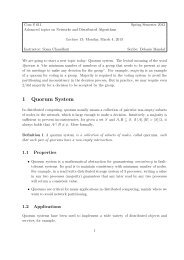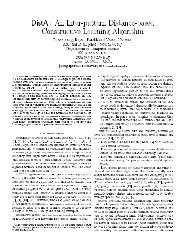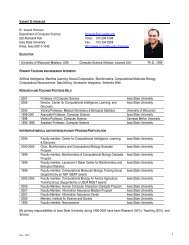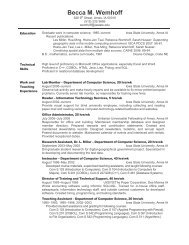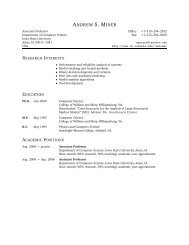Quaternions and Rotations∗ - Iowa State University
Quaternions and Rotations∗ - Iowa State University
Quaternions and Rotations∗ - Iowa State University
You also want an ePaper? Increase the reach of your titles
YUMPU automatically turns print PDFs into web optimized ePapers that Google loves.
i = (1,0,0), j = (0,1,0), k = (0,0,1). A quaternion q is defined as the sum of a scalar q 0 <strong>and</strong> a<br />
vector q = (q 1 ,q 2 ,q 3 ); namely,<br />
2.1 Addition <strong>and</strong> Multiplication<br />
q = q 0 + q = q 0 + q 1 i + q 2 j + q 3 k.<br />
Addition of two quaternions acts componentwise. More specifically, consider the quaternion q above<br />
<strong>and</strong> another quaternion<br />
p = p 0 + p 1 i + p 2 j + p 3 k.<br />
Then we have<br />
p + q = (p 0 + q 0 ) + (p 1 + q 1 )i + (p 2 + q 2 )j + (p 3 + q 3 )k.<br />
Every quaternion q has a negative −q with components −q i , i = 0,1,2,3.<br />
The product of two quaternions satisfies these fundamental rules introduced by Hamilton:<br />
i 2 = j 2 = k 2 = ijk = −1,<br />
ij = k = −ji,<br />
jk = i = −kj,<br />
ki = j = −ik.<br />
Now we can give the product of two quaternions p <strong>and</strong> q:<br />
pq = (p 0 + p 1 i + p 2 j + p 3 k)(q 0 + q 1 i + q 2 j + q 3 k)<br />
= p 0 q 0 − (p 1 q 1 + p 2 q 2 + p 3 q 3 ) + p 0 (q 1 i + q 2 j + q 3 k) + q 0 (p 1 i + p 2 j + p 3 k)<br />
+(p 2 q 3 − p 3 q 2 )i + (p 3 q 1 − p 1 q 3 )j + (p 1 q 2 − p 2 q 1 )k.<br />
Whew! It is too long to remember or even to underst<strong>and</strong> what is going on. Fortunately, we can<br />
utilize the inner product <strong>and</strong> cross product of two vectors in R 3 to write the above quaternion<br />
product in a more concise form:<br />
pq = p 0 q 0 − p · q + p 0 q + q 0 p + p × q. (1)<br />
In the above, p = (p 1 ,p 2 ,p 3 ) <strong>and</strong> q = (q 1 ,q 2 ,q 3 ) are the vector parts of p <strong>and</strong> q, respectively.<br />
Example 1. Suppose the two vectors are given as follows:<br />
p = 3 + i − 2j + k,<br />
q = 2 − i + 2j + 3k.<br />
We single out their vector parts p = (1, −2, 1) <strong>and</strong> q = (−1, 2, 3) <strong>and</strong> calculate their inner <strong>and</strong> cross products:<br />
p · q = −2,<br />
i j k<br />
p × q =<br />
1 −2 1<br />
∣ −1 2 3 ∣<br />
= −8i − 4j.<br />
2



